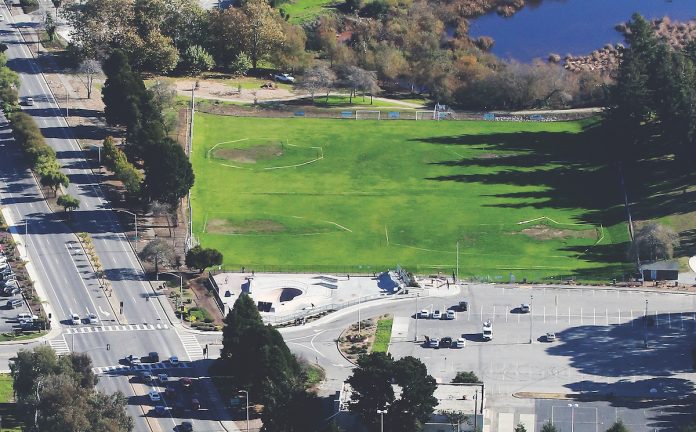[This is part two of a two-part series. Part one ran last week. — Editor]
WATSONVILLE—Watsonville Parks and Community Services Director Nick Calubaquib says since he was hired in 2018 that he has seen county officials make a stronger effort to reinvest in South County’s parks. That same year, the County of Santa Cruz finalized its parks strategic plan, which identified equity as one of its core values and said that there should be a “focus on those most in need.”
A survey done by the Trust for Public Land for that plan found that Watsonville scored the worst of the four county cities, netting 51.5 points out of 100 in the so-called ParkScore. Additionally, Watsonville, according to that survey, was spending $50 per resident on parks and recreation. Santa Cruz ($164), Capitola ($151) and Scotts Valley ($141) were all spending nearly three times the amount.
Recently, the county has made small improvements to its anchor South County park, Pinto Lake County Park. In 2018, it added a pump track and in the months since then it has made improvements to the fields, play structures and restrooms, says County Parks Director Jeff Gaffney. They’ve also made renovations to Mesa Village Park, which is just a short walk from Pinto Lake on Green Valley Road.
But the county is now setting its sights on something much bigger: finding a viable location for a new South County park.
Much like the city of Watsonville, however, the county has limited resources to do that, Gaffney says. It wasn’t until 2014, with the passing of Measure F, an $8.50 parcel tax, that county parks broke off from public works and became its own department. Add to those funding deficiencies, Gaffney says, the sacred status of farmland surrounding the county’s southernmost city. Agricultural fields have been a cash cow for the county and the local economy, bringing in a whopping $625 million in 2019, according to the agricultural commissioner’s crop report from that year.
“We don’t want to compete with a prime ag land or land that can be used for other sustainable means rather than parks,” Gaffney said. “It’s difficult to find that land that isn’t going to be used for something that has a higher or better value for the community.”
The ideal plan to create a park from scratch in South County, Gaffney says, is a multi-agency partnership in which they all pool funds and bring in private donors. He points to the recently constructed Seacliff Skatepark spearheaded by local philanthropist Rowland Rebele and Richard Novak, founder of the NHS skateboard company. Along with those two giants, Friends of Santa Cruz County Parks joined the team and were instrumental in drumming up community support for the project, Gaffney says.
“If it wouldn’t have been for them, we wouldn’t have been able to build that,” he said. “That’s the perfect example of how that could work…That’s how it’s gonna have to happen.”
Although Gaffney and Calubaquib have been trying to lay the groundwork for something similar in South County, the interest has been lukewarm, Gaffney says. Talks with the Land Trust of Santa Cruz County have fallen flat, and similar discussions with Santa Cruz County Fairgrounds are still ongoing but slow developing.
Fourth District County Supervisor Greg Caput says a public-private partnership would help fund the purchase of a 38-acre lot near the fairgrounds that would give South County another recreation asset. The county currently has about 25% of the lot’s $2 million price tag saved up, and Caput says they are pursuing grants to fund the remaining balance.
In a best-case scenario, the massive project could go to the county planning department within the year, Caput says. It would mark the first purchase of land for park use in the Fourth District in decades, he adds.
“We need more recreation space,” he said. “It’s a great location. It could be for soccer, football or baseball…. It would be a real good asset for South County.”
Removing barriers
Watsonville filmmaker Carlos Campos says that he started playing soccer when he was 5. He stopped playing organized ball just before he began attending Watsonville High School, a boys’ soccer powerhouse ranked near the top of the state nearly every year. But like many in Watsonville, Campos continues playing pick-up soccer with his friends.
Finding a field to play a game, he says, is nearly impossible. When in playable condition, Sotomayor Field at Ramsay Park is usually taken by competitive teams from sunrise to sunset. And most fields at area schools are off limits, either locked behind a fence or already filled by clubs that have ‘handshake deals’ with administrators overseeing those campuses.
Most times, Campos says, the team using a field allows his group of friends to play on a small corner of a school’s turf. Other times, they hop the fence to play a half-hour or so on fields that otherwise sit vacant.
“It’s understood by the community that ‘we rather have you playing here than doing something else somewhere else that’s not proactive,’” he said. “At least that’s what I tell myself. If I had a soccer field, I would want kids playing soccer [rather] than not being proactive, doing drugs or something different somewhere else.”
The Pajaro Valley Unified School District and city are trying to come to a compromise to remove those barriers. The agencies signed a joint-use agreement in August of last year, opening up Ann Soldo and Radcliff elementary schools and E.A. Hall Middle School for public use when classes are not in session.
The agreement is still in its “pilot” phase, meaning there is no long term guarantee that those fields will stay open after it expires. But there has been a commitment from both sides to give the agreement a fair shot. The initial contract expired in December 2020, but to get a better understanding of any possible hiccups that might occur during a full-fledged agreement, the PVUSD Board of Trustees is expected to extend the agreement through December 2021 in an upcoming meeting.
In its first six months PVUSD Superintendent Michelle Rodriguez says the program has seen positive results. There were initial concerns that schools open to the public would be more prone to vandalism, but that has not been the case, Rodriguez says. However, cleanup crews have found those campuses did see an uptick in trash, including empty alcohol containers.
“That’s the whole reason for the pilot…to figure out how we could curtail any challenges that can come up,” Rodriguez said. “The good thing about [PVUSD and the city] is we aren’t deterred by challenges.”
The renewed agreement will only include Ann Soldo and E.A. Hall. Radcliff was removed from the program because the district received several complaints from a group of neighbors whose backyards are adjacent to the school’s field, says Watsonville City Councilman Aurelio Gonzalez, an original champion of the joint-use agreement.
Those neighbors said they experienced an uptick in the number of homeless people in the area, and that there was too much additional noise and balls flying into their backyards, Gonzalez says.
“It’s like everything when you start it, there’s the bumps and the faults and you see how everything works out,” Gonzalez said.
Ultimately, Gonzalez hopes that E.A. Hall, which falls in his district, can turn into the poster child for the joint-use agreement. Soon, that school will feature a long awaited all-weather turf field, and its dirt track might also see an upgrade. Its baseball fields, too, are undergoing upgrades thanks to an agreement with Pajaro Valley Little League that Gonzalez helped broker. He envisions the school’s campus becoming a community hub for the surrounding neighborhood.
“We lack park space as a community,” he said. “I’m still pushing for that, and I want more schools to open up.”
Opening up all of PVUSD’s schools in Watsonville, Calubaquib says, would bring the city to its park acreage goal of 5 acres per 1,000 residents, but several questions must be answered before that can happen. Possibly the biggest question: just how much more wear and tear will the district’s fields be subject to. With Covid-19 restrictions on youth sports and public gatherings relaxing, the district and city might get a better answer in the coming months—the city’s youth sports programs are set to return in May.
Joint-use agreements are not a new thing, Calubaquib says, but the long-term thinking behind the current contract is. In the past, the city entered into agreements with individual school principals that would often end when that principal left. The current agreement, Calubaquib says, has been in the works since he returned to the city in 2018.
“Moving people to come around on the idea has taken some time, but I know there’s a lot of board of trustee members that are supportive of this idea,” Calubaquib said. “It’s a huge step in the right direction and I’m hoping we can continue to grow this partnership.”











